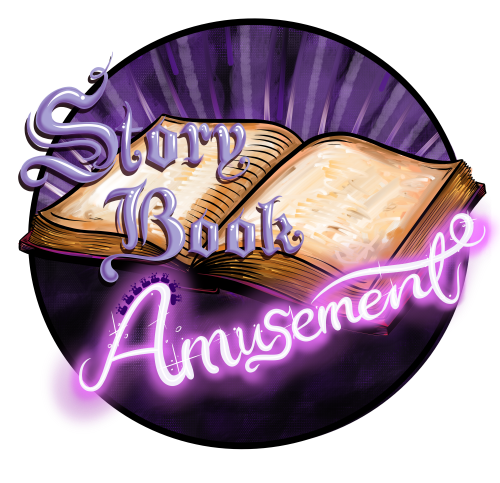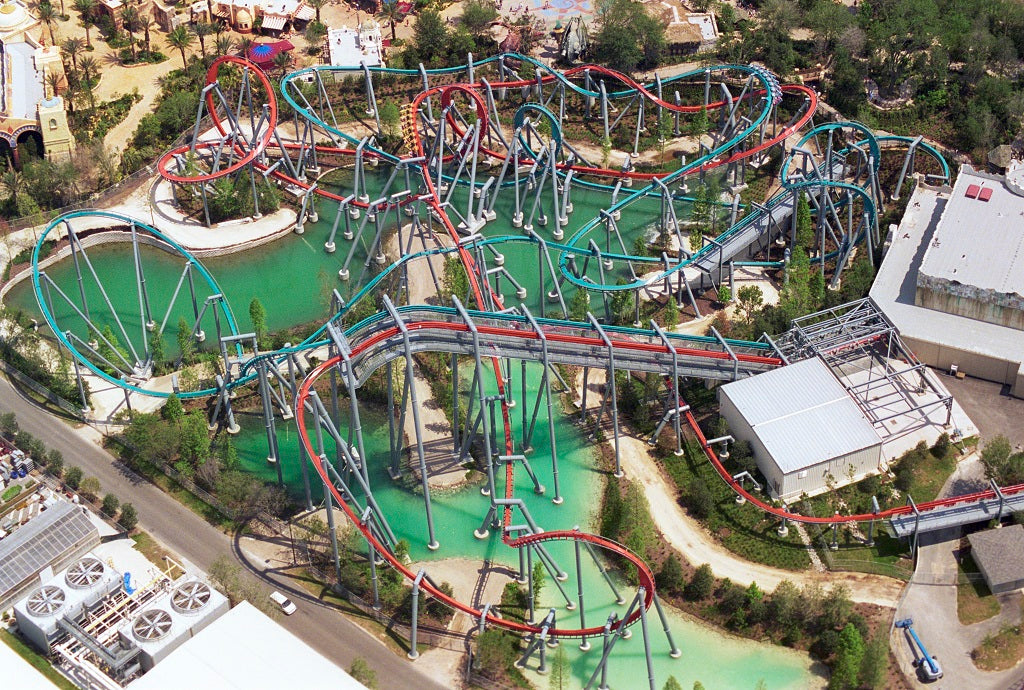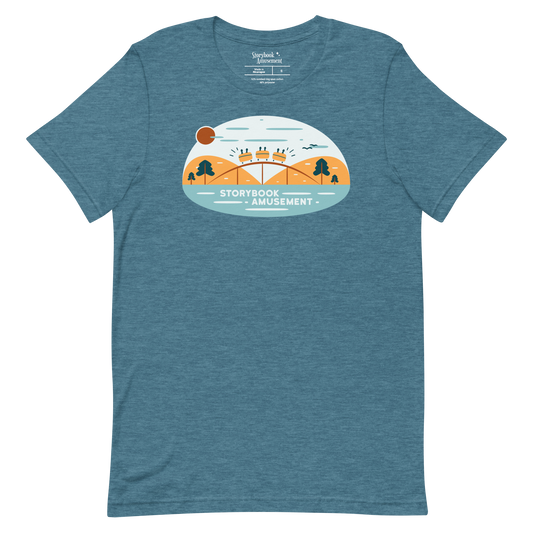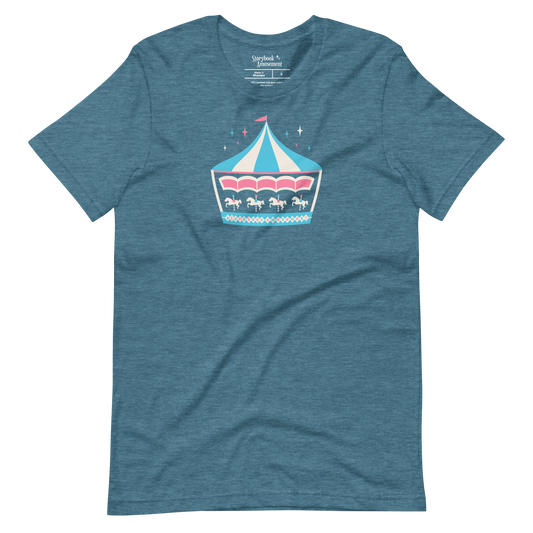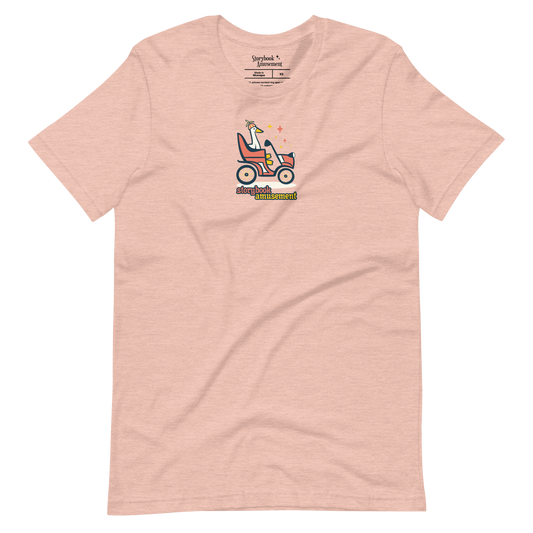The Thrilling Battle of Fire and Ice
A castle, buried in a distant forest, battered to rubble, overtaken by opposing beasts. The unrest of a mighty battle frozen in time. Dueling Dragons stood among Islands of Adventure’s headlining attractions for the better part of two decades.
Let’s sift through the scrolls and annals of theme park history to uncover the dynasty and destiny of Dueling Dragons.
Watch on YouTube
This article is available in video form with added visuals. Click HERE to watch it.
Chapter I: Origin
Universal Studios Florida by the mid-'90s was in a position to expand into a multi-park destination. For its second gate in Orlando, Universal would stray from its traditional studio-based park, settling on a more immersive experience that put guests in the middle of fanciful worlds. Universal Creative moved forward with the concept for a new park called Islands of Adventure.
Beastly Influences
Meanwhile, during the same time frame, Walt Disney World had been developing its newest theme park: Animal Kingdom. For the park, Disney had Imagineered an area called Beastly Kingdom, which would have featured creatures from legend and folklore such as unicorns, sea monsters, and dragons. The land’s proposed E-ticket attraction was an indoor suspended coaster called Dragon’s Tower—an experience in that guests would soar through a crumbling castle ruled by a treasure-obsessed, fire-breathing dragon.
As Animal Kingdom’s design became more ambitious, its budget became tighter, causing the company to cut a portion of the park’s plans. Ultimately, Disney shelved Beastly Kingdom for budget reasons.
Rumors suggest Disney laid off Imagineers who worked on the project; supposedly, the former designers of Disney’s Beastly Kingdom found work at Universal for its upcoming theme park. This group is said to have played a major role in developing one of Islands of Adventure’s six themed areas: The Lost Continent.
Introducing: The Lost Continent
Based on mythology, adventurous worlds, and medieval folklore, The Lost Continent would be split up into three sections: Lost City, Sinbad's Bazaar, and Merlinwood—the latter being themed to the sights, stories, and settings of the middle ages.
The Lost Continent, while by no means a direct copy of Beastly Kingdom, coincidentally had noticeable influences from the canceled Disney concept. Most notably, the Creative team had repurposed the idea of a suspended coaster with a dragon and castle theme.
Universal teamed up with Swiss coaster manufacturer Bolliger & Mabillard to develop a pair of intertwining, inverted dueling coasters. B&M at that point had worked on noteworthy rides such as Batman: The Ride, Kumba, Montu, and the yet-to-be-built Incredible Hulk Coaster. In coordination with Universal Creative, the coaster layouts were engineered by roller coaster pioneer Werner Stengel and would feature near-miss elements made possible by the two tracks’ interacting with one another.
Looping in a Theme
Universal Creative had workshopped the ride's premise and storyline, naming it Merlin’s Duelling Dragons, “Duelling” being spelled with two Ls. Parkwide executive creative director Dale Mason and attraction writer Ross Osterman formed the ride, its architecture, characters, and plot based on the 1958 book The Once and Future King by T.H. White.
The attraction was set to take place in Merlin’s castle, now overruled by fierce, opposing dragons. Early plans for the queue included a lower chamber in the castle that would have featured menacing dragon shadows as well as fire and water projection effects. These scenes were cut for budget reasons, and the attraction’s name was ultimately simplified to Dueling Dragons, with one L.
In the late-‘90s, Universal teased the upcoming coasters’ plans in the Islands of Adventure Preview Center, located in the building to the left of Kongfrontation in Universal Studios Florida.
After park previews through the summer, Dueling Dragons officially opened to the public when Islands of Adventure debuted May 28, 1999.
Chapter II: Reign
Through innovative design and execution, the brand-new Islands of Adventure immersed guests into stories brought to life with mysteries and excitement around every corner. Passing by a towering lighthouse and trekking to the back of the park, guests would find themselves in Merlinwood, which was the medieval section of The Lost Continent. This medieval area was where magic and wonder took dominion over civilization—where enchanted creatures retreated from the Known World.
There, two monstrous, polar dragons made from stone stood motionless, forever snarling at one another. This was the facade and entrance of The Lost Continent’s marquee attraction: Dueling Dragons.
The dragon statues, which were built by Adirondack Studios, were wrapped around two collapsing columns: one topped with a glowing ice crystal and the other capped with a flame. This facade was designed perfectly to see all three of the dueling coasters’ signature near-miss elements lined up in one vantage point on Merlinwood’s main midway.
Entering the Queue
To enter, guests would walk up a short stairway and onto a path in between the rival dragon statues. As the light and bouncy soundtrack swelled to a majestic theme, the path ventured through a winding forest. Walking among the foliage, guests could feel gusts of wind from dragons’ soaring nearby.
The pathway continued, arriving at a castle beaten to ruins. It was convincing, as if it had been sitting abandoned for hundreds of years. In this castle dwelt two dragons, Blizzrock and Pyrock. They had ruled and devastated the fractured castle. Better known as Ice and Fire, these two dragons were a twisting pair of intertwining inverted coasters on the castle’s grounds, caught in the flurry of a constant, heated battle.
Guests would pass the castle doors and enter through a blown-out hole in the wall—more destruction caused by the dragons. Just inside the dimly lit castle was a preshow animated on stained-glass windows, which told the attraction’s backstory.
The Story-Driven Preshow
As it goes, Merlin, who had been stripped of nearly all his magic, was the protector of a once-prosperous castle. That was, until two restless, demonic dragons seized the kingdom, fighting over its land and treasures. With opposing powers—fire and ice—they recklessly battled each other, pausing only to vanquish any foolish human who challenged them. The powerful dragons defeated the king’s army.
So, in desperation, the kingdom turned to the castle’s protector, Merlin. Alas, the weakened sorcerer couldn’t contain the two beasts, and the dragons ravaged the castle, devastating the structure to rubble. With waning walls departed in the forest, the castle remained, as did the dragons and Merlin. Guests could make it out alive by riding on the backs of Blizzrock and Pyrock.
The preshow was only the beginning of the attraction’s creative storytelling and design.
Inside the Castle
The mystique intensified through the queue as the soundtrack and ambiance grew darker. The second room, which was a small tower, had Merlin’s spellbook, listing out the sorcery he used in attempts to vanquish the rampant dragons.
The next room, cracked and dilapidated from the dragons, was lined with charred knights pinned to the wall—the remains of Pyrock’s victims. The Ice dragon claimed his territory in the next room, known as the Hall of the Dead, with frozen knights thrown in the decaying rafters surrounded by a sea of candles.
From there, guests would walk into a small chamber outfitted with deteriorating furniture and a fireplace—what once was a homey castle has now been made a desolate battleground for dragons. With flickering lights, the echos of cave drippings, and a low rumble of dragon roars, this room led guests past a set of ominous wooden doors. Guests could feel the dragons’ presence from behind these doors. The sounds of booming growls and heavy breathing made it seem as if two dragons were trying to barge through.
Lanterns guided the way through the remainder of the queue, taking guests through catacombs that led to the basement where the dragons burrowed. These caverns were textured with skeletons and skulls, even on the very floor guests walked on. These carved-out hallways became more and more menacing with every step, with spine-chilling sounds and Merlin detailing out the terror waiting at the end of the path.
Shrines with messages written out in bones gave a warning to guests—no one let their guard down in these claustrophobic tunnels. About this section of the queue, Universal Creative art director Catherynne A. Jean said, “And finally the darkest corridor was sculpted to feel like you had touched the skin of the dragon—and later saw the eye of the dragon peering at you.”
Choose Thy Fate
It’s here that guests were left with a choice: Choose thy fate—a message that was also written above in ancient Latin. Merlin’s voice could be heard, giving one last protection to guests as he cautioned, “Pick your poison: fire or ice.”
The path split—guests went either left for Fire or right for Ice. Each side led to a short hallway and into the attraction’s joint loading station. Above the room's archways, guests could see silhouettes on the cloth ceiling of dragons soaring and climbing.
Facing the Dragons
Before guests boarded the coaster, empty ride vehicles pulled into the station. These trains, while functionally identical to those on other B&M inverts, were decorated with custom designs that were sculpted and painted by Blaine Kern Studios, a company renowned for producing Mardi Gras floats.
The attraction had a total of six different 32-passenger trains: three for each track. The restraints on each train’s front row had pink harnesses to look like open mouths and tongues. The other rows had blue or red harnesses, matching the dragon theming that looked as if the seats were being held by their claws.
The Dueling Dragons Ride Experience
Dueling Dragons was a pair of inverted coasters and consisted of two unique, independent layouts that offered different ride experiences. Both recreated the sensation of flying with a dragon, including inversions and other extreme coaster elements; Ice’s track was a bit more graceful, and Fire’s was slightly more intense. Together, Dueling Dragons had three near-miss elements, bringing riders’ feet within as little as 18 inches of the opposing train.
For the dueling elements to properly line up, each train was weighed on a straight piece of track before the 135-foot lift hill. The computer would determine, based on each train’s weight, when to properly release them at the top of the chain lift hill. This process ensured the timing would cause the trains to line up on the tracks, making for the best ride experience during the near-miss elements.
These head-to-head, or toe-to-toe, elements were a camelback airtime hill for Fire, gliding over Ice’s zero-G roll; two mirrored vertical loops; and two intertwining corkscrews. Other notable elements on the ride were Fire’s Immelmann directly into a helix and Ice’s whippy cobra roll right up against the castle wall. Additionally, Fire’s first drop was 20 feet longer than Ice’s.
Unlike the queue, the coaster track area was relatively unthemed except for foliage and the castle walls from the queue building. Dueling Dragons’ steel track mostly sat over a body of water, which earned the name Dragon Lake—this was originally planned to be in the shape of a dragon but was obscured for logistical reasons.
While the coasters were testing and in preview periods, nearby residents complained that the volume from the attraction was too disruptive. In response, Universal constructed a 55-foot-tall sound barrier wall in April 1999 around Islands of Adventure’s perimeter by the coaster.
Reception
Dueling Dragons was among the park’s more popular attractions upon opening. Universal anticipated this, and, due to high estimated wait times, the queue was originally over half a mile long. Operationally, Dueling Dragons was a high-capacity attraction that, when running all its trains on both tracks, could in theory accommodate nearly 3,000 guests per hour. This attraction had the highest capacity on property; for comparison, this was about 1,000 more guests per hour than The Incredible Hulk Coaster.
With Dueling Dragons being such a high-capacity ride, wait times were lower than anticipated as the line moved very quickly. This was because there was one queue for two coasters.
In 2000, one year after the park opened, Universal replaced Dueling Dragons’ outdoor extended queue area with a new junior coaster called Flying Unicorn, which also had a storyline based around Merlin.
Dueling Dragons was accompanied by a gift shop called The Dragon’s Keep and remained as one of the park’s marquee rides throughout its early years.
Chapter III: Dethroned
In 2007, Universal announced The Wizarding World of Harry Potter would debut at Universal Orlando Resort. To make way for the new land, a portion of The Lost Continent area would be deconstructed and rethemed to the famed book and movie series. However, the land’s major attraction, Dueling Dragons, would carry over to The Wizarding World after cosmetic and thematic updates. With this attraction being in the middle of the area, leaving it as Dueling Dragons wasn’t an option because it would not thematically fit with the rest of The Wizarding World; Universal had no choice but to retheme it.
During construction for the new area, Dueling Dragons remained open in its original form. The attraction’s entrance in September 2008 was temporarily relocated to the Jurassic Park area of Islands of Adventure near The Watering Hole restaurant.
A month later, the classic Dueling Dragons sculpture facade was demolished. The interim entrance’s sign was the Flying Unicorn’s old sign with the Dueling Dragons logo printed on it. This entry directed guests onto the bridge that connects Jurassic Park and the Wizarding World area.
In early 2010, Dueling Dragons officially closed to receive its Harry Potter updates.
A Wizarding Update
On June 18, 2010, The Wizarding World of Harry Potter – Hogsmeade opened to the public with huge crowds. The area's three rides were the brand-new Harry Potter and the Forbidden Journey; Flight of the Hippogriff, formerly Flying Unicorn; and Dragon Challenge, formerly Dueling Dragons. The twin coasters, now under Harry Potter theming, were based around the story of the Triwizard Tournament as told in the series’ fourth book and movie: Harry Potter and the Goblet of Fire.
The New Dragon Challenge Experience
Dragon Challenge began with a less prominent facade, which was simply a stone wall and an entryway. Above it was the attraction’s name carved out and the first of four golden eggs, tying back to the Triwizard Tournament storyline. The queue, which had nearly the same layout as the previous version’s, started on a path through a light forest. Along this section, guests could hear John Williams’ elegant themes from the Harry Potter movies and walked by banners representing various competitors in the Tournament, mainly Potter and Diggory.
The queue offered a great view of Hogwarts Castle on the left through a break in the trees. The path would then pass Hagrid’s hut and a grounded Ford Anglia as used in the movies with a humming motor. A bridge, now decorated with flags above, took guests to the castle entrance. This version of the ride used a formal entryway rather than a hole in the wall caused by dragons. A sign that read “Welcome Triwizard Champions” hung above the entry, with vines covering the seasoned castle walls.
Inside the Rethemed Castle
Immediately inside, guests walked through a Triwizard tent area; this space formerly was the stained glass preshow room. The tent had props such as a Nimbus 2000, The Goblet of Fire, and more. Guests with Express passes would go right, and the regular standby queue continued left.
From there, guests would walk down a short hallway and then into a circular room that looped around a screen-used Triwizard Cup—complete with enchanting lighting effects. This room previously had Merlin’s spellbook on display. With a mysterious, regal soundtrack blaring, the queue would continue through another hallway that ended at a small room that previously had Pyrock’s victims pinned to the walls.
The music slowly lessened to an ambient, high drone that echoed off the ageless castle walls. Just outside that room were the remaining three golden dragon eggs in a glass case. This led into a room lined with elaborately woven tapestries, which remained from Dueling Dragons, and floating candles in the rafters, shining against darkness like stars in the night sky. In the Dueling Dragons days, this corridor was filled with Blizzrock’s ice-covered victims.
After that, guests would walk through faintly lit corridors. These passageways had low visibility and relatively barren theming. Some areas had cavities in the walls where skulls and skeletons used to be from the former version of the ride. The most prominent set piece in this stretch of the queue was a set of wooden doors—updated for this version of the ride. Like before, the doors would vibrate from the vicious, thunderous roars coming from behind.
Aside from that, this part of the queue was stripped of most props. The winding, dungeon-like walkways led to a familiar room where the path would branch off—left for red, right for blue. The two dragons were now called the Chinese Fireball and Hungarian Horntail, respectively. Both come from the Harry Potter storyline. The left and right paths each led to their separate loading stations, mirrored from one another.
The Dragons Dueled No More
Dragon Challenge’s ride experience, including the train design, was exactly the same as that of Dueling Dragons, including its signature dueling element. However, the attraction overall felt lessened after the imposed Potter theming. What made Dueling Dragons special before was its queue, which during its Potter years featured weaker storytelling, especially when compared to the Hogwarts-themed queue next door. Dragon Challenge, an attraction that already had its prime cut short, would suffer even more.
Due to incidents involving loose articles and the attraction’s near-miss elements, Universal in October 2011 permanently suspended the ride’s dueling. This meant that the trains no longer dispatched at the same time. This of course was to increase safety and minimize the risk of future incidents. Instead of synchronized operations, the attraction then practiced under staggered operations. Riders could no longer experience the dueling aspect the attraction was originally named after.
The ride experience was now vastly different from how it was on opening day. Rather than flying along another train full of riders, the ride felt lacking when coming within inches of an empty opposing track—to put a positive spin on it, it was almost as if the dragons were chasing each other, but the experience regardless was missing something.
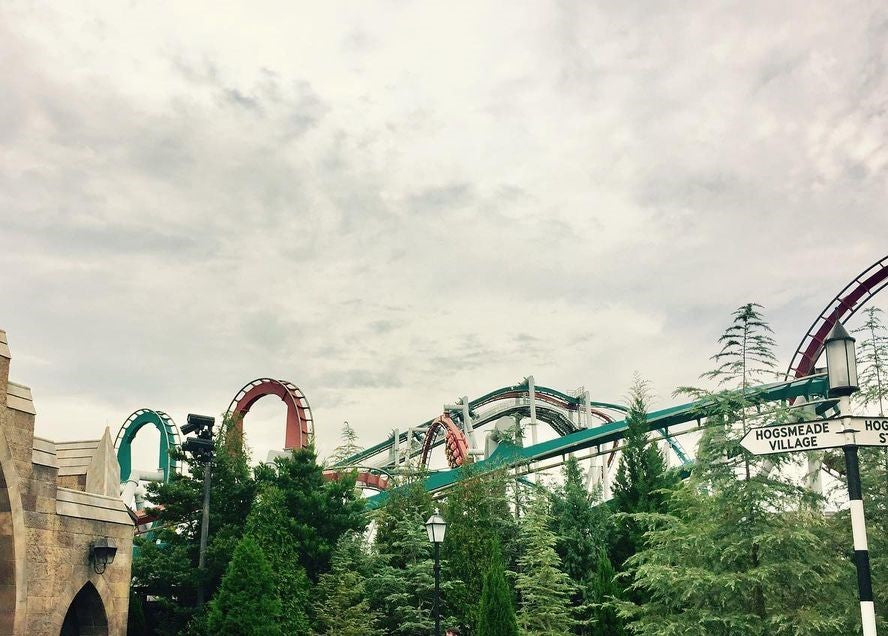
While still good coasters on their own, between the bare queue and the discontinued dueling, Dragon Challenge was well beyond its golden years.
In 2015, Universal added another safety feature to the attraction, requiring all guests to pass through a metal detector before riding. This was to assure riders did not have any loose articles when on the attraction. Before entering the queue, riders had to store all their loose articles in a free locker outside of the attraction’s entrance. This new policy gave fans hope that the dragons might again one day duel; however, that hope would soon turn to sorrow.
Chapter IV: Demise
More than 15 years into its life, Dragon Challenge, formerly known as Dueling Dragons, did not have an optimistic future. The attraction usually had low wait times—partly because of its high throughput, partly because of its lack of dueling, and partly because of the hassle guests had to go through to get a locker to ride.
Considering the attraction’s large footprint, Universal had their eyes set on Dragon Challenge’s prime plot of land for a Wizarding World expansion. As a part of The Wizarding World, Dragon Challenge was never highly featured in any of the land’s marketing, leading many to believe the attraction wasn’t in Universal’s long-term plans.
At one point, these flapping dragon wings were the very heartbeat of Islands of Adventure. In the late 2010s, that pulse would slowly come to a still.
Retiring the Dragons
Universal Orlando Resort announced in July 2017 that Dragon Challenge would close Sept. 4 of that year after 18 years of operation. In the announcement, Universal encouraged fans to come for final rides before the twin coasters closed for good. This decision was made due to the attraction’s declining popularity, due to the coaster tracks most likely nearing the end of their service lives, and to make way for an all-new Wizarding World experience.
One Final Flight
On its final day, the ride drew large crowds and higher wait times but also unfortunately experienced extended delays and downtime due to inclement weather. Thus, because of this, Dragon Challenge unexpectedly was closed during its final moments.
The attraction’s final flight was underwhelming for coaster as adored as this one. Despite missing an opportunity for final rides, fans gathered at the attraction’s entrance for an unofficial closing ceremony, sharing personal and passionate sentiments about the dragons. One fan, wearing a vintage Dueling Dragons T-shirt, recited the script from the original preshow as told on the animated stained-glass windows.
Fans wearing their Dueling Dragons T-shirts to say goodbye to Dragon Challenge @UniversalORL pic.twitter.com/IvTrDgJTIq
— Attractions Magazine (@Attractions) September 4, 2017
The Attraction's Future
After the ride closed, fans and enthusiasts speculated that the coaster tracks may be disassembled, sold, and relocated to another park outside of the Universal chain. Ultimately, the tracks were completely dismantled and scrapped—the true end of an era. With this closure, Dueling Dragons was the first, and so far only, B&M coaster to be removed and made entirely defunct.
With a ride as popular as this one, its replacement would certainly have the pressure of being a worthy successor.
A Magical Replacement
With much anticipation, Hagrid’s Magical Creature Motorbike Adventure opened June 13, 2019, taking over the former plot of land once ruled by raging rival dragons.
The new attraction, which is currently the most expensive coaster ever built at an estimated $300 million, repurposed the existing castle queue, completely and impressively retheming it to a decommissioned section of Hogwarts. Its floorplan is for the most part identical to queues formerly in this building. Needless to say, the new coaster has been a worthy replacement, serving as a perfect fit for Hogsmeade.
The legendary Dueling Dragons queue is a thing of the past. But, we may see hints of it at HHN this year.
— Storybook Amusement (@StorybookAmuse) August 8, 2023
Some of the queue's layout is still recognizable today inside the Hagrid’s Motorbike Adventure line.
Here's a little comparison. Can you spot the similarities? pic.twitter.com/qlo2rhVx27
Chapter V: Legacy
Operating under Dueling Dragons, this pair of coasters impressed fans and critics. The attraction received high praise, consistently earning a top 25 spot in the Golden Ticket Awards’ best steel coasters category. To accomplish what Dueling Dragons achieved took a lot of innovation.
Easter (Dragon) Eggs

Upon opening and through its glory days, these coasters were well-known and were still adored past their primes. Today, the defunct attraction is still honored in small ways in the park. For one, on Hagrid’s Magical Creature Motorbike Adventure, a marking that reads “Dueling Club” with red and blue dragons is painted on the wall almost immediately inside the new queue. A lesser-known nod can be spotted in Diagon Alley over the area’s exit. A uniform from the former Dragon Challenge attraction hangs on a clothesline among the lived-in theming up above.
The Dragons Take a Frightful Flight
In 2023, Universal Orlando Resort announced its annual Halloween Horror Nights event would feature a house themed to the original Dueling Dragons attraction. The haunted house will be called Dueling Dragons: Choose Thy Fate.
Haunted House: Two powerful warlocks invade Merlyn’s castle to take his spell book and are turned into dragons of fire and ice. Now you and your friends are caught in their fight and must choose a path and a victor. pic.twitter.com/nVFJ9BTduQ
— Halloween Horror Nights (@HorrorNightsORL) July 30, 2023
Long Live Blizzrock and Pyrock
Dueling Dragons, later known as Dragon Challenge, was a high-speed journey that came and went too fast—yet, its impact on fans, the park, and the industry will continue to live on.
